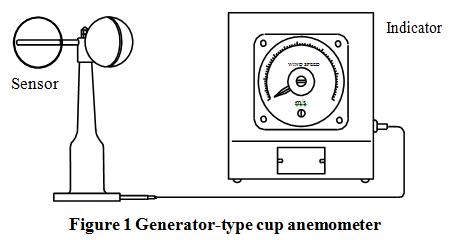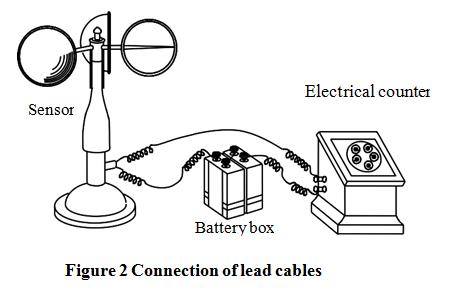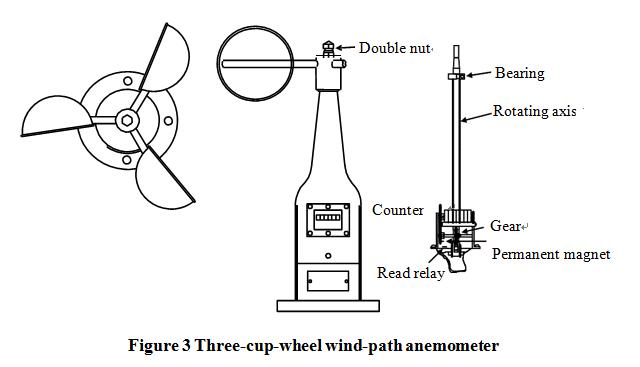1) Generator-type Cup Anemometers
This type has a small AC generator coupled to its axis. The wind turns the cups and the generator to generate a voltage proportional to the instantaneous wind speed, and the signal is transmitted to the indicator (Figure 1). The CR integrated circuit calculates the average wind speed as the circuit charges and discharges the capacitor over a certain period. This type of anemometer is located in an exposed position on a tower and is connected to an indicator through cables, and observation from remote locations is possible. The greatest distance between the anemometer and the indicator depends on the electrical resistance of the cable and the design (a model allows a maximum distance of 1,500 m). This type of anemometer does not require a power supply for the main unit, but the counter takes 3-volt dry-cell batteries (Figure 2).
Recent models are equipped with an A/D (analog to digital) converter to allow computer processing of data tasks.
The generator-type cup anemometer generates wind speed signals by itself, and can be used without an electrical supply.


2) Pulse Generator-type Cup Anemometers
A pulse generator-type cup anemometer counts the number of cup-wheel rotations, which is proportional to the wind passage. The number of rotations in a particular period (such as ten minutes) is counted, and the wind passage is obtained by multiplying the factor specified for the anemometer (e.g., 54 rotations for a wind passage of 100 m) by this number. The wind speed is obtained by dividing the wind passage by the number of time units in this period.
The optical pulse generator type is mainly used now, having replaced the electrical contact breaker type. An optical pulse generator consists of a perforated disk (called a chopper disk) directly fixed to the rotating axis of the cup wheel and a photocoupler. As the cup wheel rotates, the chopper disk turns and either allows the passage of or interrupts a beam of light between the light transmitter and the light receiver of the photocoupler, creating pulse signals with a frequency proportional to wind speed. After P/A (pulse-analog) conversion, a DC voltage proportional to the number of pulses in a specific period is generated. This voltage is then converted to give an instantaneous wind speed. Some cup anemometers with a pulse generator digitize signals and indicate the instantaneous wind speed with a microprocessor. CR integrated circuit or microprocessor are used to obtain the average wind speed.
The chopper disk and photocoupler of a pulse generator-type cup anemometer can be made small. The weight of a pulse generator-type cup anemometer can be less than that of the generator in a generator-type cup anemometer, allowing improved starting threshold speed and response characteristics.
3) Mechanical-type Cup Anemometers
A much simpler method for measurement of wind speed using a cup anemometer is to count the number of cup revolutions. A mechanical-type cup anemometer indicates the number of cup rotations through gears connected to the sensor axis. Specifically, the increment (wind passage) of indication over a period of ten minutes before the observation is read and the average wind speed are obtained by dividing the wind passage by 10 minutes (600 seconds) (Figure 3).

This type of anemometer has a number of advantages: it does not require a power supply, its structure is simple, and it remains relatively problem-free. However, its body is connected to the counter, and it is necessary to go outdoors to read the counter for each instance of observation. A type of anemometer with a reed-relay directly connected to the counter is available to eliminate the need to go outside to obtain readings, as the generated contact signals are counted with an electric counter indoors. In such cases, a DC 3V power supply is required for the electric counter.
